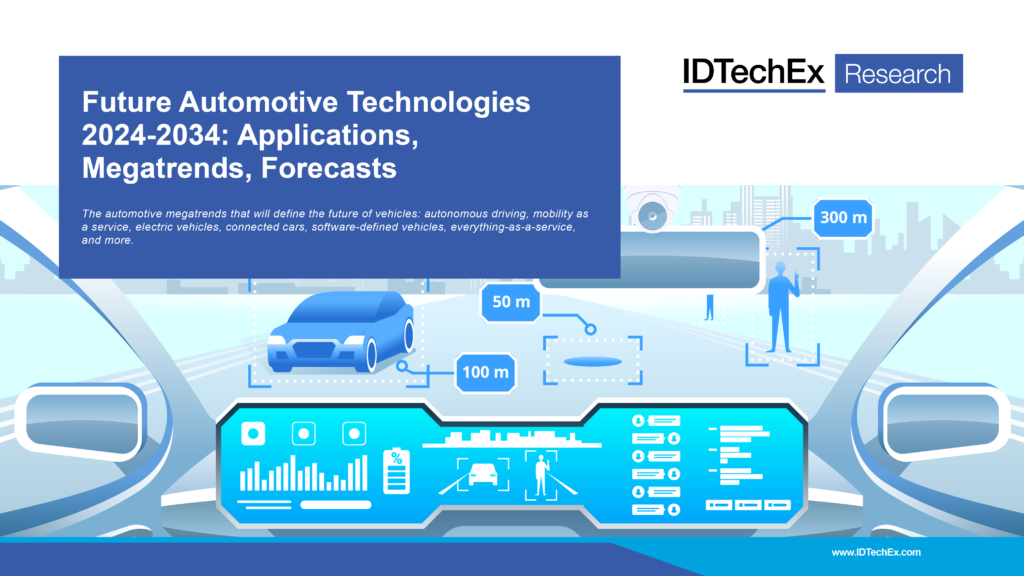For more information, visit https://www.idtechex.com/en/research-report/future-automotive-technologies-2024-2034-applications-megatrends-forecasts/979.
The automotive megatrends that will define the future of vehicles: autonomous driving, mobility as a service, electric vehicles, connected cars, software-defined vehicles, everything-as-a-service, and more.
Autonomous driving technologies and vehicle electrification are megatrends that are reshaping the automotive industry. In addition to these, connected and software defined vehicles have recently emerged with the potential to create new revenue streams, while safety applications from in-cabin monitoring will drive the market for a variety of sensors. “Future Automotive Technologies 2024-2034: Applications, Megatrends, Forecasts” covers all these technologies, highlighting at a high level what these technologies are, what is driving them, where the opportunity is, and how much they will be worth. Between the new services that they provide and the components they require, IDTechEx predicts a market value of more than US$1.6 trillion in 2034.

Autonomous driving
There are two significant opportunities to be aware of when it comes to autonomous driving: the growth of automotive perception sensors market and the creation of an autonomous mobility industry. The former already has a market size of more than US$10 billion, mostly dominated by cameras and radars for ADAS (advanced driver assistance system) applications. Technologies under this umbrella include adaptive cruise control, automatic emergency braking and lane keep assist. These typically require a combination of radars and cameras and are already ubiquitous across the automotive industry, with partially automated SAE level 2 vehicles now commonplace amongst new car sales. This hardware market will continue to see growth through further penetration of level 2 technologies, but it is the emergence of SAE level 3 technologies which will drive the predicted 10-year CAGR of 13.6%. In 2022 and 2023 the Mercedes S-Class has been bringing SAE level 3 self-driving technologies to consumers in multiple regions, this represents a watershed moment after which the journey toward widespread availability of level 3 technologies begins. “Future Automotive Technologies 2024-2034: Applications, Megatrends, Forecasts” provides forecasts that show how level 3 technologies will spread across the market and what impact it will have on the demand for cameras, radar and LiDAR.
Autonomous driving also promises a cheap and safe form of mobility provided by robotaxis. These will carry even more sensors than consumer vehicles, with each robotaxi possessing a suite worth into the tens of thousands of dollars presently. However, the fiscal opportunity that they offer has more to do with the service they provide than the hardware they require. The total car fleet already travels more than ten trillion miles annually, as robotaxis start to take some of this demand they will generate hundreds of billions of dollars in revenue. This report provides analysis of current robotaxi performance and deployment and forecasts their city by city spread and progression toward a mainstream alternative to car ownership.
Electrification
In 2022 and 2023 electric cars have made the transition from early adopter technology to mainstream. Their necessity has been foreshadowed by increasing pressure to decarbonise the automotive industry and reduce the impact to the climate. Looming bans on internal combustion engines (ICE) from different nations combined with manufacturers’ internal ICE phase-out targets means that their future dominance is almost certain.
The opportunity they bring to the automotive industry is through the new components they require. Large lithium-ion batteries, powerful traction motors, and accompanying power electronics have not previously had a place in the automotive market. In 2023 these components combine to create a market size of more than US$100 million, which will grow significantly over this report’s 10-year forecast, making up a significant part of the US$1.6 trillion future automotive technologies market.
Connected and Software-Defined Vehicles
Connectivity is nothing new in vehicles, for many years now they have had the ability to communicate key information back to OEMs. The paradigm shift is coming from how OEMs are using the vehicle’s connectivity and modern luxury features to create new revenue streams. IDTechEx has already seen some optional extras, like heated steering wheels, transitioning to a subscription model, so that customers only need to pay for it in the winter. New luxury features, like advanced assisted and automated driving systems, are becoming more defined by the vehicle’s software than its hardware. Subscription models can be created which keep the vehicle up to date and everything working smoothly.
In addition to new luxury features in the vehicle, connectivity can support payments via the car. Future vehicles will be able to pay for parking, pay for charging, and even pay for drive through coffee, automatically. Of course, the intention is that the OEMs will be able to take a transaction fee of some kind helping them to create new profit through vehicle connectivity. This report provides an overview of applications enabled by connectivity, what software-defined vehicles mean and what they can offer, what the enabling technologies are and how large revenue from services will be in 2034.
In-cabin sensing
Since early lane keep assist systems, where the vehicle could effectively steer itself to a limited degree, cars have needed a way to tell whether the driver is still holding onto the wheel. The easiest way to do this was with a torque sensor in the steering system that could infer from its measurements whether the driver was still holding the wheel. However, these could be fooled, and with modern ADAS systems inspiring so much confidence in their own abilities, combined with the emergence of level 3 systems which offer hands off driving in certain situations, more sophisticated driver monitoring systems are required.
This report highlights the new technologies that are emerging to keep a track of the driver’s attentiveness and protect from left behind children and pets. The pros and cons of each system are explained, and their market prospects forecasted.
Through these megatrends the automotive industry is seeing irreversible transformation from a status quo that has lasted for decades. The way customers drive, interact with, and own their vehicles is changing. The 10-year forecasts in this report bring together the most disruptive technologies coming to the automotive industry.


